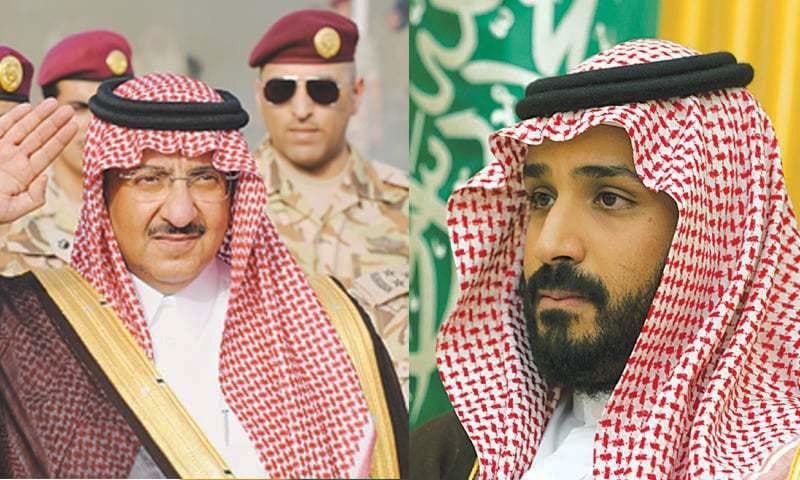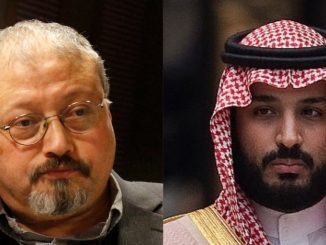
As next in line to be king of Saudi Arabia, Mohammed bin Nayef was unaccustomed to being told what to do. Then, one night in June, he was summoned to a palace in Mecca, held against his will and pressured for hours to give up his claim to the throne, New York Times said in a new report about Mohammed Bin Salman’s plot to replace his cousin Mohammed Bin Nayef as Saudi crown prince.
“By dawn, he had given in, and Saudi Arabia woke to the news that it had a new crown prince: the king’s 31-year-old son, Mohammed bin Salman,” the NYT report continued to say.
Ambitious prince
The young prince’s supporters have lauded his elevation as the seamless empowerment of an ambitious leader. But since he was promoted on June 21, indications have emerged that Mohammed bin Salman plotted the ouster and that the transition was rockier than has been publicly portrayed, according to current and former United States officials and associates of the royal family.
To strengthen support for the sudden change in the line of succession, some senior princes were told that Mohammed bin Nayef was unfit to be king because of a drug problem, according to an associate of the royal family.
The decision to oust Mohammed bin Nayef and some of his closest colleagues has spread concern among counterterrorism officials in the United States who saw their most trusted Saudi contacts disappear and have struggled to build new relationships.
And the collection of so much power by one young royal, Prince Mohammed bin Salman, has unsettled a royal family long guided by consensus and deference to elders.
“You may have now such a concentration of power within one branch and within one individual who is also younger than so many of the cousins and sons of former kings that it may begin to create a situation where the family is out of whack,” said Kristian Coates Ulrichsen, a fellow for the Middle East at Rice University’s Baker Institute for Public Policy, who studies Persian Gulf politics.
The insularity of Saudi Arabia’s sprawling and phenomenally wealthy royal family is well known, often leaving diplomats, intelligence agents and members of the family itself struggling to decipher its inner workings.
But since The New York Times reported last month that Mohammed bin Nayef had been confined to his palace, United States officials and associates of senior royals have provided similar accounts of how the elder prince was pressured to step aside by the younger one. All spoke on the condition of anonymity so as not to endanger their contacts inside the kingdom, or themselves.
In response to questions from The Times, a written statement by a senior Saudi official denied that Mohammed bin Nayef had been pressured and said that the Allegiance Council, a body of senior princes, had approved the change in “the best interest of the nation.”
The statement said Mohammed bin Nayef was the first to pledge allegiance to the new crown prince and had insisted that the moment be filmed and broadcast. The former crown prince receives guests daily in his palace in Jidda and has visited the king and the crown prince more than once, the statement said.
The rivalry between the princes began in 2015, when King Salman ascended the throne and bestowed tremendous power on his favorite son.
Mohammed bin Salman was named deputy crown prince, or second in line to become king, as well as defense minister; put in charge of a powerful economic council; and given oversight of the state oil monopoly, Saudi Aramco.
Mohammed bin Salman elevated his profile with visits to China, Russia and the United States, where he met with Mark Zuckerberg, the Facebook chief executive, and dined with President Trump in the White House. He has also guided Vision 2030, an ambitious plan for the future of the kingdom that seeks to transform the Saudi economy and improve life for citizens.
Mohammed bin Salman’s supporters praise him as a hard-working visionary who has addressed the kingdom’s challenges with extraordinary directness. His programs, including increasing entertainment opportunities inside the hyperconservative kingdom, have won him fans among the two-thirds of Saudis who are younger than 30.
But his critics call him rash and power-hungry, saying he has entangled the country in a costly and so far failed war in Yemen that has killed many civilians, as well as in a feud with Qatar. Neither has a clear exit.
The prince has risen at the expense of his elder relatives, including Mohammed bin Nayef, 57. As the head of the Saudi Interior Ministry, Mohammed bin Nayef led the dismantling of Al Qaeda in the kingdom after a deadly bombing campaign a decade ago. While he kept a low public profile, even after becoming crown prince in 2015, his work won him allies in the United States and other Western and Arab nations.
But while his removal struck many as sudden, it had been planned out.
On the night of June 20, a group of senior princes and security officials gathered at the Safa Palace in Mecca after being informed that King Salman wanted to see them, according to United States officials and associates of the royal family.
It was near the end of Ramadan, the Islamic holy month, when Saudis were preoccupied with religious duties and many royals had gathered in Mecca before traveling abroad for the Eid al-Fitr holiday. That made it advantageous for a change, analysts said, like a coup on Christmas Eve.
Before midnight, Mohammed bin Nayef was told he was going to meet the king and was led into another room, where royal court officials took away his phones and pressured him to give up his posts as crown prince and interior minister, according to United States officials and an associate of the royal family.
At first, he refused. But as the night wore on, the prince, a diabetic who suffers from the effects of a 2009 assassination attempt by a suicide bomber, grew tired.
Meanwhile, royal court officials called members of the Allegiance Council, a body of princes who are supposed to approve changes to the line of succession. Some were told that Mohammed bin Nayef had a drug problem and was unfit to be king, according to an associate of the royal family.
For years, close friends of Mohammed bin Nayef had expressed concern about his health, noting that since the assassination attempt, he had experienced lingering pain and shown signs of post-traumatic stress disorder. His condition led him to take medication that some friends worried he had become addicted to.
“The weight of the evidence I have seen is that he was more injured in the assassination attempt than was admitted and that he then got onto a pain killer routine that was very addictive,” said Bruce Riedel, a former Central Intelligence Agency officer and director of the Intelligence Project at the Brookings Institution. “I think that problem got progressively worse.”
One American official and one adviser to a Saudi royal said Mohammed bin Nayef opposed the embargo on Qatar, a stand that probably accelerated his ouster.
Sometime before dawn, Mohammed bin Nayef agreed to resign. A video shot afterward shows Mohammed bin Salman kissing his hand.
“We will never dispense with your instructions and advice,” the younger prince says.
“Good luck, God willing,” the older prince replies.
Mohammed bin Nayef then returned to his palace in the Red Sea port city of Jidda, and he was barred from leaving it.
Also confined to his home was Gen. Abdulaziz al-Huwairini, a colleague of Mohammed bin Nayef who was crucial to the security relationship with the United States, according to current and former United States officials.
Days later, C.I.A. officials briefed the White House on their concern that the ouster of Mohammed bin Nayef and the possible removal General Huwairini and other security officers could hamper intelligence sharing, United States officials said.
The senior Saudi official’s statement said General Huwairini was still in his job and had pledged allegiance to Mohammed bin Salman along with senior officers.
Mohammed bin Nayef was replaced as interior minister by his 33-year-old nephew, Prince Abdulaziz bin Saud bin Nayef, who was an adviser to his uncle and who is believed to be close to Mohammed bin Salman.
The extent of support for the elevation of Mohammed bin Salman in the family remains unclear. Saudi state news media reported that 31 of the 34 members of the Allegiance Council supported the change, but analysts said many royals are hesitant to vote against the king’s wishes.
Some United States officials and well-connected Saudis say there are rumblings of discontent, and analysts have pointed out hints.
Neither King Salman nor his son attended the Group of 20 summit meeting in Hamburg, Germany, even though one of the two men had attended each of the last three meetings. Analysts say that family disputes may have kept the men at home or that they did not want to face criticism for the isolation they and three other Arab states imposed on Qatar.
The senior Saudi official said King Salman and his predecessor, King Abdullah, had skipped previous Group of 20 meetings.
Saudis shocked by the changes say they have a lot to lose if splits within the family spill into the open and destabilize the kingdom.
“It’s not like people are going to go out on the street and say, ‘We want M.B.N.,’ ” said one associate of the royal family, using Mohammed bin Nayef’s initials. “We want this family. We want to preserve them as best we can.”



